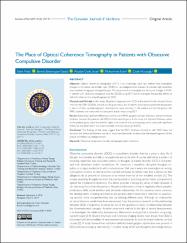| dc.contributor.author | Polat, Selim | |
| dc.contributor.author | Gediz, Berrak Şekeryapan | |
| dc.contributor.author | Ercan, Alaattin Cenk | |
| dc.contributor.author | Kaim, Muhammet | |
| dc.contributor.author | Hocaoğlu, Çiçek | |
| dc.date.accessioned | 2020-12-19T20:42:37Z | |
| dc.date.available | 2020-12-19T20:42:37Z | |
| dc.date.issued | 2019 | |
| dc.identifier.citation | Polat, S., Gediz, B.S., ercan, A.C., Kaim, M., Hocaoğlu, Ç. (2019). The place of optical coherence tomography in patients with obsessive compulsive disorder. Eurasian Journal of Medicine, 237-241. | en_US |
| dc.identifier.issn | 1308-8734 | |
| dc.identifier.issn | 1308-8742 | |
| dc.identifier.uri | https://doi.org/10.5152/eurasianjmed.2019.18306 | |
| dc.identifier.uri | https://app.trdizin.gov.tr/makale/TXpNek9ERTVPUT09 | |
| dc.identifier.uri | https://hdl.handle.net/11436/5747 | |
| dc.description.abstract | Objective: Optical coherence tomography (OCT) is an increasingly used new method that investigates changes in the retinal nerve fiber layer (RNFL) in neurodegenerative diseases. It provides high-resolution cross-sectional imaging of biological tissues. This study aimed to investigate the structural changes in RNFL in patients with obsessive compulsive disorder (OCD) using OCT and to investigate the possible effects of retinal function on the etiopathogenesis of OCD. Materials and Methods: In this study, 30 patients diagnosed with OCD at the end of the Structured Clinical Interview for DSM (SCID-I), without any drug use status, and 31 healthy participants paired with the patients in terms of their sociodemographic characteristics were included. In the patient and control groups, the RNFL thickness was measured and compared at each locus using OCT. Results: Statistically significant differences were found in RNFL, ganglion cell layer thickness, and central foveal thickness between the patients with OCD and the control group. In this study, the choroidal thickness values of the patient group were found to be higher than those of the control group; and a statistically significant difference was observed in the mean choroidal thickness values (p=0.045). Conclusion: The findings of the study suggest that the RNFL thickness of patients with OCD does not decrease, but choroidal thickness may be an important biomarker to determine the etiopathogenesis of the disease and follow neurodegeneration. | en_US |
| dc.language.iso | eng | en_US |
| dc.publisher | AVES | en_US |
| dc.rights | info:eu-repo/semantics/openAccess | en_US |
| dc.subject | Genel ve Dahili Tıp | en_US |
| dc.subject | Obsesif Kompulsif Bozukluk | en_US |
| dc.subject | Tomografi | en_US |
| dc.subject | Optik Uyum | en_US |
| dc.title | The place of optical coherence tomography in patients with obsessive compulsive disorder | en_US |
| dc.type | article | en_US |
| dc.contributor.department | RTEÜ, Tıp Fakültesi, Cerrahi Tıp Bilimleri Bölümü | en_US |
| dc.contributor.institutionauthor | Polat, Selim | |
| dc.contributor.institutionauthor | Kaım, Muhammet | |
| dc.contributor.institutionauthor | Hocaoğlu, Çiçek | |
| dc.identifier.doi | 10.5152/eurasianjmed.2019.18306 | |
| dc.identifier.volume | 51 | en_US |
| dc.identifier.issue | 3 | en_US |
| dc.identifier.startpage | 237 | en_US |
| dc.identifier.endpage | 241 | en_US |
| dc.ri.edit | oa | en_US |
| dc.relation.journal | Eurasian Journal of Medicine | en_US |
| dc.relation.publicationcategory | Makale - Uluslararası Hakemli Dergi - Kurum Öğretim Elemanı | en_US |


















